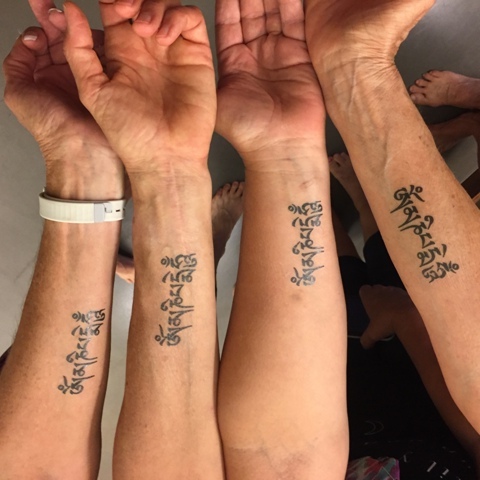Do I have to want to become a yoga teacher to take a yoga teacher training program?
No. Some people take teacher training as a way to learn more about yoga in general and their own practice in particular. However, there will be a portion of the program where you will need to step up and teach to your fellow classmates. It is often surprising to students how much they feel like they know their teacher’s script by heart but when it comes time to tell someone else how to come into Warrior II, they can’t find the words. One of the best ways to make sure that you know something inside and out is to have to explain it to someone else.
I love yoga and think I want to teach it, but I don’t see myself teaching yoga in a large class in a studio or a gym.
Teaching yoga, as I do, in a large group class in a studio or gym is not the only way to teach yoga. There are many ways to specialize in teaching yoga:
You can teach privates only.
There are opportunities to teach in the corporate world; lots of companies offer yoga as a perk to their staff.
Find your own special niche: pre-natal yoga, yoga for people in recovery, women who have been abused, kids, teens, seniors, retirement communities, teaching people in nursing homes, people who have MS.
However in order to branch out into any of these specialties you will need a basic 200 hour program under your belt, first.
I can’t touch my toes, stand on my head, do a split or wheel. Can I still become a yoga teacher?
OMG! Yes! I couldn’t touch my toes for the longest time when I first began teaching yoga. I thought I wasn’t good enough, or a “real” yoga teacher because of that.
But, what I saw as a detriment actually became a skill. If the yoga poses come easily to you, you might not understand why others can’t do the things you can do. I had to figure out how to touch my toes and that skill helped me explain to others what they needed to learn and do in order to become more flexible, too. I learned a lot about flexibility, both mental and physical, anatomy, alignment, the physiology of stretching plus patience and surrender, too. All of these lessons served to help me become a better teacher. I knew about the hard work and dedication necessary to achieve a pose. I also knew about the dangers of caring too much about achieving a pose and pushing too hard and getting injured in the process!
While there are some people who can do everything, most people seem to be better in one group of poses over another, and they have to work hard at those other poses to make progress and to stay balanced. If that is the way you are, then you will have to learn how to modify and use props and to be inventive as to how to get at the pose from another angle. You also learn lessons of patience, acceptance and surrender.
If you can’t do advanced poses, you probably won’t attract those students to you who want to do those poses, but this is a good thing. I recommend that new teachers: “teach only what you know”. As your practice and skills develop, you will be able to teach more poses.
An important thing to note is that most people may not be looking to be able to place their foot behind their head. It takes a lot of time and commitment to be able to do those kinds of poses. About a year ago, I took a survey of my yoga students asking them what they wanted out of their yoga practice. The top five responses had more to do with finding peace and serenity than they did with doing advanced poses.
How long should one have been practicing yoga before beginning a yoga teacher training program?
When I first started training yoga teachers, I thought people should have at least three years of practice before embarking on a teacher training program. The more you know about yoga and the more adept your practice is, the more you will absorb from the training program. However, one of my friends and students said that she signed up for teacher training after only one yoga class. Now, she had been teaching other forms of fitness before. But, once she found yoga, she just fell in love with it. I like to encourage students to follow their passion.
Before the founding of Yoga Alliance and the 200 hour certification requirement, it used to be that you apprenticed with a teacher for at least ten years before you would start to teach. When that teacher felt that you knew enough to teach, they would encourage you to do so. People don’t want to wait that long these days. But one of the things that makes sense from that model is the idea of practicing for a long enough time to get past the honeymoon stage of the practice. If you practice for long enough something usually happens that creates a disturbance in your practice: an illness, injury or outside commitment. Sometimes circumstances make it difficult to get onto your mat. If there is a hiatus in practice, beginning again can be humbling. Going through that cycle is extremely educational.
Am I too old or too young to do a teacher training program?
The beginning of the Yoga Sutras starts with Atha Yoganusasanam, which means “Now Yoga”. This can be interpreted to mean that now is the right time to start yoga. If you are considering becoming a yoga teacher, only you know if it is plausible for you to move forward towards that dream. With more than 36 million yoga practitioners in the US, it seems that there should be plenty of yoga students to go around. You might have questions of time or finances, but age should not be a limiting factor.
I don’t think you can be too old or too young to begin to teach yoga. You will probably attract students who are close to you in age as your interests in the type of practice will be more similar. Younger students may be more fearless and want to have a faster paced, harder workout. Older students may appreciate a little more time to move into poses. They may be more cautious and have more physical limitations. As a more mature yoga teacher, age will give you experience, wisdom and sympathy for the diversity you may come across in a yoga class.
I have back pain (or neck, shoulder, knee, hip, etc. …) Should I do a yoga teacher training program?
If this is something that you chronically struggle with, but it doesn’t keep you from living your life, then I don’t see why not. Honestly, though, only you can answer that question. If your injury or syndrome incapacitates you, then perhaps now is not the best time and you should wait until you are feeling better. However, I can tell you that your experience is common. A lot of yoga students and yoga teachers will suffer from these common ailments from time to time. Your experience can actually help students.
Look up Matthew Sanford. He is a yoga teacher who is paralyzed from the chest down. He has a book entitled Waking. It is a must read.
If you have any other questions, please feel free to contact me at mkeisen@verizon.net.

















